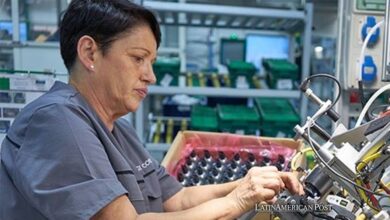Mexico’s Clean Energy Push Amid Nearshoring Boom

As nearshoring trends drive investment into Mexico, experts at the Solar +Storage México fair in Guadalajara emphasize the urgent need for expanded clean energy infrastructure to meet growing industrial demands.
In the bustling city of Guadalajara, a recent convergence of energy specialists at the Solar +Storage México fair has brought to light a crucial challenge for Mexico’s economic and environmental future. As global manufacturing dynamics shift and companies increasingly relocate production closer to the United States, Mexico finds itself at a crossroads, needing to substantially boost its clean energy output to cater to these new investments.
Opportunity and Challenges in Nearshoring
Nearshoring, the practice of transferring a business operation to a nearby country rather than a far-off one, is not just a logistical change but a strategic move that enhances the efficiency of supply chains and minimizes environmental impact. This represents a golden opportunity for Mexico to reimagine its industrial base and embrace technological advancements. However, it also poses significant challenges in scaling up infrastructure to meet this shift’s heightened energy demands.
Jesús Carrillo, director of sustainable economics at the Mexican Institute for Competitiveness (IMCO) and a speaker at the fair, highlighted the dual nature of this opportunity. “It demands that Mexico accelerate its energy transition efforts. This reindustrialization of the United States and the rapid technological shifts it entails favor financing and installations and enhance the ecosystem for an energy transition,” Carrillo explained during an interview.
Despite the Mexican government’s ambitious goal to generate at least 35% of its energy from clean sources by the end of 2024, progress has been slow. In 2023, only 22% of energy came from renewable sources, as the nation still heavily relies on fossil fuels.
In response, the government has committed to modernizing 16 hydroelectric plants to increase annual clean energy output by 1,085 gigawatts per hour and developing solar parks along the U.S.-Mexico border and a photovoltaic solar park in Puerto Peñasco, Sonora. These initiatives are steps toward meeting domestic energy needs and ensuring that the infrastructure can support the influx of businesses relocating to Mexico.
Environmental Compliance and Infrastructure Challenges
Luis Stone, CEO of Ergosolar and another expert speaker at the fair, pointed out that while nearshoring companies are attracted by factors such as qualified human resources and security, environmental compliance is also a critical criterion. “With the current pace of growth in clean energy, Mexico’s infrastructure is not yet capable of supporting nearshoring on a large scale,” Stone noted. He suggested that isolated supply models might temporarily satisfy the demands of foreign companies with lower energy needs.
Moreover, the experts called for public policies encouraging further investment in energy transmission and distribution. Carrillo disclosed that in recent years, significant funds allocated for these purposes by the Federal Electricity Commission needed to be more utilized, with only 30% and 50% of the allocated resources being spent in 2021 and 2022, respectively.
The Solar +Storage México fair itself serves as a platform to address these issues. It brings together 200 exhibitors showcasing comprehensive solutions and services for the energy sector across 8,000 square meters. The event underscores the critical role of sustainable practices and the circular economy in Mexico’s energy transition.
This push towards clean energy is not just a local or national issue but part of a larger regional narrative across Latin America, where many countries are grappling with the need to balance economic growth with environmental sustainability. Nations like Chile and Argentina have also made significant strides in renewable energy to power their nearshoring prospects.
As Mexico continues to navigate these complex dynamics, the interplay of government policy, corporate investment, and technological innovation will be crucial. The country’s ability to harness its renewable energy potential shapes its economic landscape and its standing on the global stage as a leader in sustainable industrialization.
Also read: Banda Music Controversy: Balancing Tradition and Business in Mexico
With nearshoring set to redefine North America’s economic contours, Mexico’s journey towards a cleaner, more sustainable energy future will undoubtedly influence the region’s ecological footprint and its economic resilience in the face of global shifts.





